Organisational Behaviour Report: Culture, Politics, and Performance
VerifiedAdded on 2020/07/22
|16
|4992
|33
Report
AI Summary
This report provides an in-depth analysis of organisational behaviour, focusing on the impact of culture, politics, and power on both team and individual performance within the context of "A David & Co Limited", a food flavor company. The report utilizes Handy's cultural typology to understand the influence of different cultural models (power, role, task, and person) on employee behavior and productivity. It explores the application of content and process theories of motivation, including reinforcement, expectancy, equity, and goal-setting theories, to enhance employee engagement. Furthermore, the report examines the characteristics of effective and ineffective teams, and evaluates team development theories to improve business outcomes. The report concludes by discussing the philosophies and concepts of organisational behaviour within a company setting, providing insights into how these factors shape employee behavior and overall organizational success. The report is a comprehensive study of organisational dynamics.
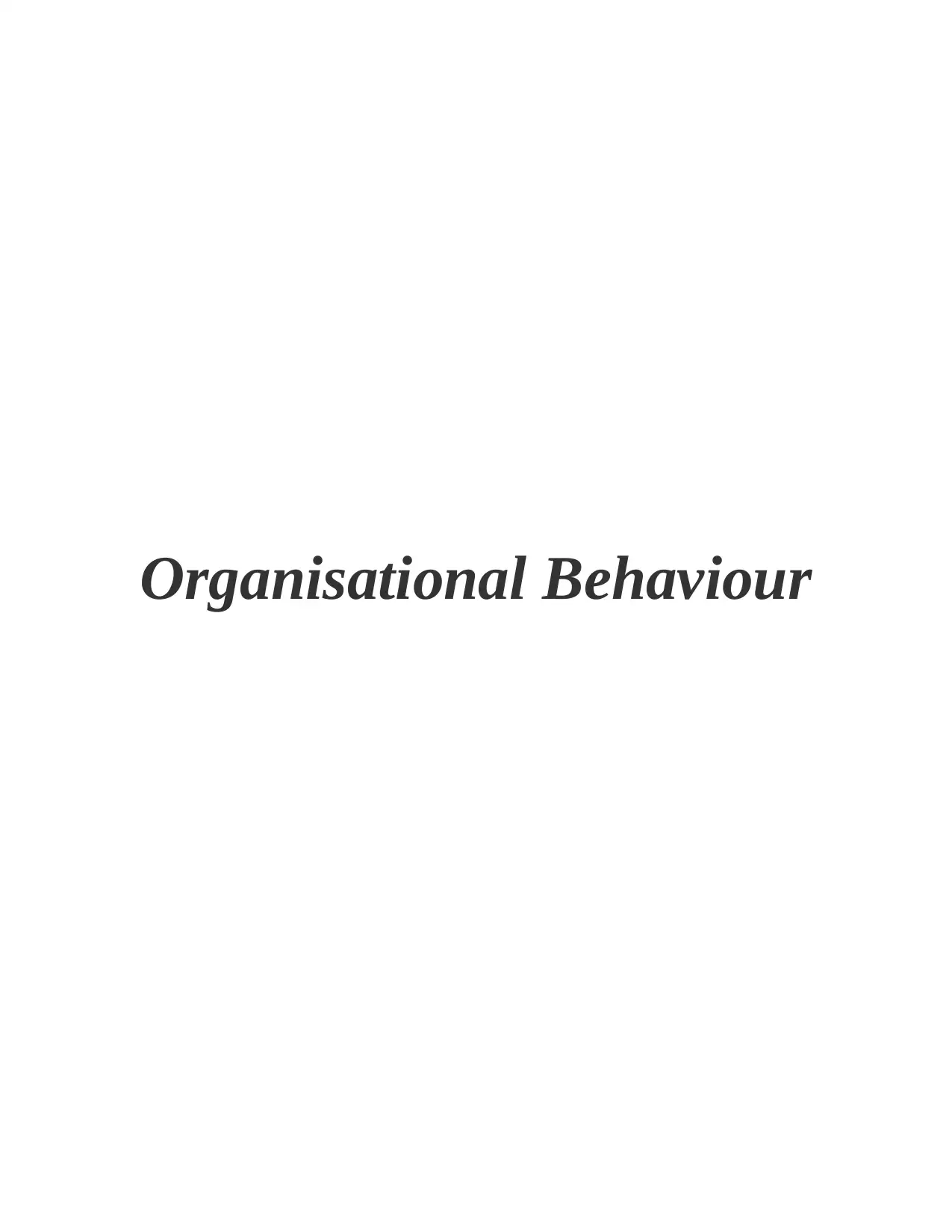
Organisational Behaviour
Paraphrase This Document
Need a fresh take? Get an instant paraphrase of this document with our AI Paraphraser
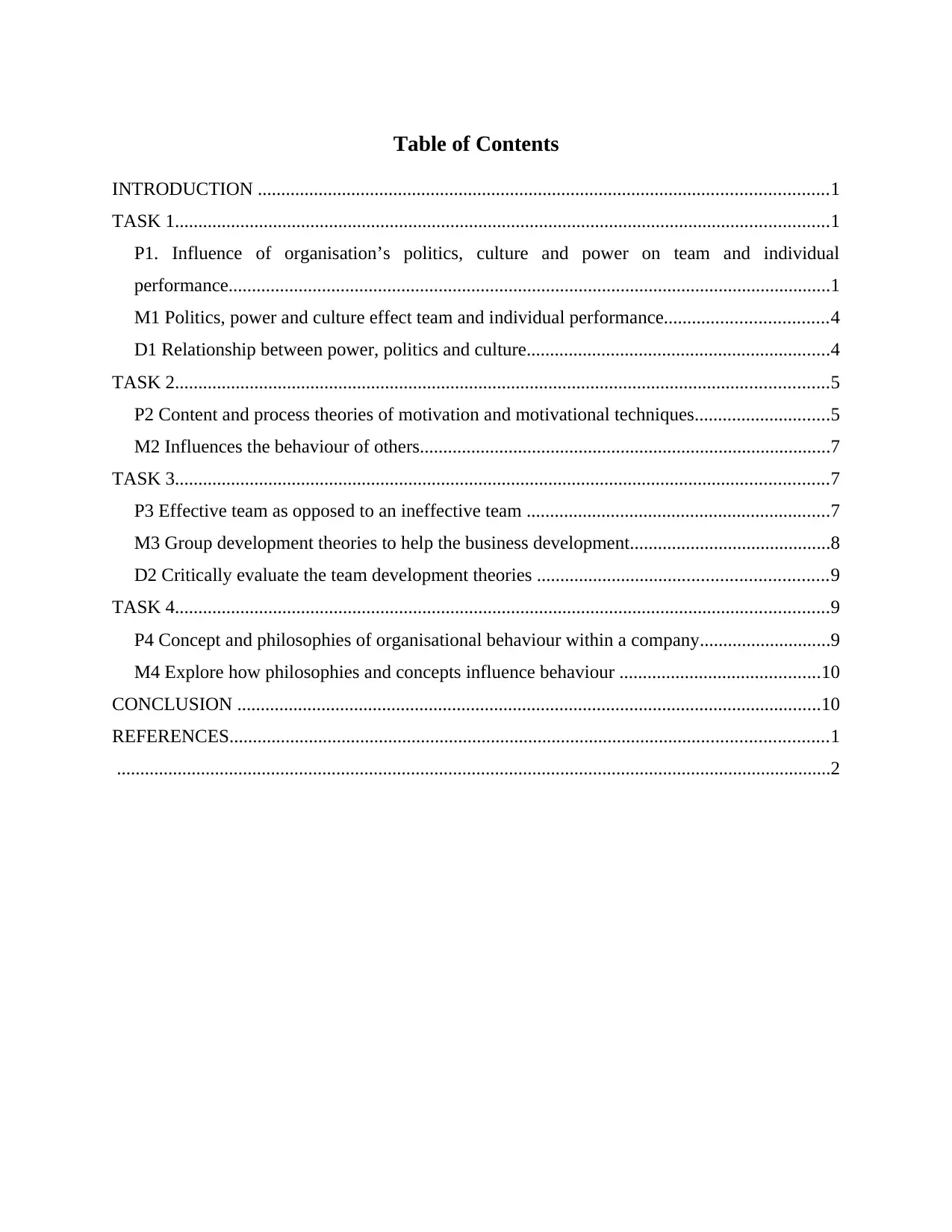
Table of Contents
INTRODUCTION ..........................................................................................................................1
TASK 1............................................................................................................................................1
P1. Influence of organisation’s politics, culture and power on team and individual
performance.................................................................................................................................1
M1 Politics, power and culture effect team and individual performance...................................4
D1 Relationship between power, politics and culture.................................................................4
TASK 2............................................................................................................................................5
P2 Content and process theories of motivation and motivational techniques.............................5
M2 Influences the behaviour of others........................................................................................7
TASK 3............................................................................................................................................7
P3 Effective team as opposed to an ineffective team .................................................................7
M3 Group development theories to help the business development...........................................8
D2 Critically evaluate the team development theories ..............................................................9
TASK 4............................................................................................................................................9
P4 Concept and philosophies of organisational behaviour within a company............................9
M4 Explore how philosophies and concepts influence behaviour ...........................................10
CONCLUSION .............................................................................................................................10
REFERENCES................................................................................................................................1
.........................................................................................................................................................2
INTRODUCTION ..........................................................................................................................1
TASK 1............................................................................................................................................1
P1. Influence of organisation’s politics, culture and power on team and individual
performance.................................................................................................................................1
M1 Politics, power and culture effect team and individual performance...................................4
D1 Relationship between power, politics and culture.................................................................4
TASK 2............................................................................................................................................5
P2 Content and process theories of motivation and motivational techniques.............................5
M2 Influences the behaviour of others........................................................................................7
TASK 3............................................................................................................................................7
P3 Effective team as opposed to an ineffective team .................................................................7
M3 Group development theories to help the business development...........................................8
D2 Critically evaluate the team development theories ..............................................................9
TASK 4............................................................................................................................................9
P4 Concept and philosophies of organisational behaviour within a company............................9
M4 Explore how philosophies and concepts influence behaviour ...........................................10
CONCLUSION .............................................................................................................................10
REFERENCES................................................................................................................................1
.........................................................................................................................................................2

⊘ This is a preview!⊘
Do you want full access?
Subscribe today to unlock all pages.

Trusted by 1+ million students worldwide
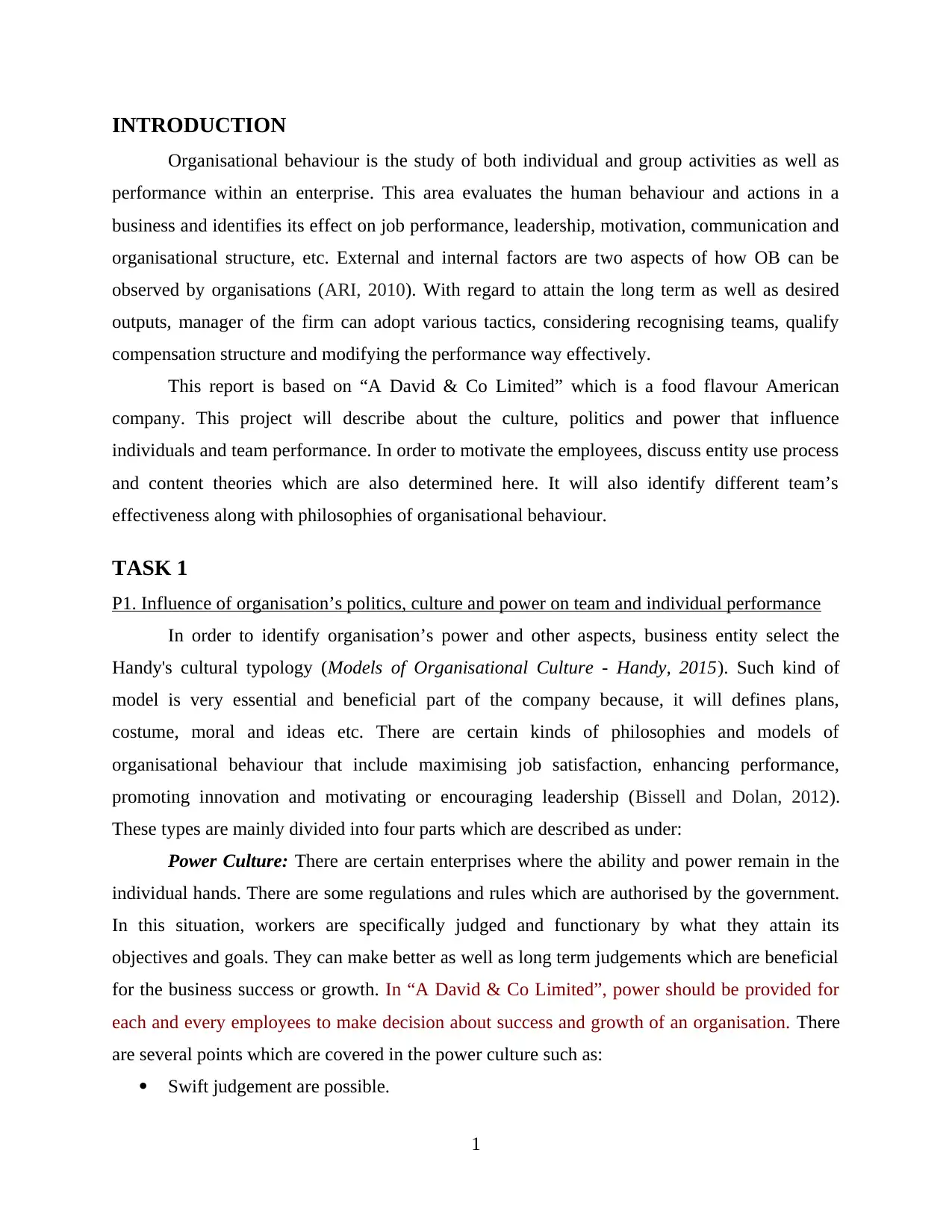
INTRODUCTION
Organisational behaviour is the study of both individual and group activities as well as
performance within an enterprise. This area evaluates the human behaviour and actions in a
business and identifies its effect on job performance, leadership, motivation, communication and
organisational structure, etc. External and internal factors are two aspects of how OB can be
observed by organisations (ARI, 2010). With regard to attain the long term as well as desired
outputs, manager of the firm can adopt various tactics, considering recognising teams, qualify
compensation structure and modifying the performance way effectively.
This report is based on “A David & Co Limited” which is a food flavour American
company. This project will describe about the culture, politics and power that influence
individuals and team performance. In order to motivate the employees, discuss entity use process
and content theories which are also determined here. It will also identify different team’s
effectiveness along with philosophies of organisational behaviour.
TASK 1
P1. Influence of organisation’s politics, culture and power on team and individual performance
In order to identify organisation’s power and other aspects, business entity select the
Handy's cultural typology (Models of Organisational Culture - Handy, 2015). Such kind of
model is very essential and beneficial part of the company because, it will defines plans,
costume, moral and ideas etc. There are certain kinds of philosophies and models of
organisational behaviour that include maximising job satisfaction, enhancing performance,
promoting innovation and motivating or encouraging leadership (Bissell and Dolan, 2012).
These types are mainly divided into four parts which are described as under:
Power Culture: There are certain enterprises where the ability and power remain in the
individual hands. There are some regulations and rules which are authorised by the government.
In this situation, workers are specifically judged and functionary by what they attain its
objectives and goals. They can make better as well as long term judgements which are beneficial
for the business success or growth. In “A David & Co Limited”, power should be provided for
each and every employees to make decision about success and growth of an organisation. There
are several points which are covered in the power culture such as:
Swift judgement are possible.
1
Organisational behaviour is the study of both individual and group activities as well as
performance within an enterprise. This area evaluates the human behaviour and actions in a
business and identifies its effect on job performance, leadership, motivation, communication and
organisational structure, etc. External and internal factors are two aspects of how OB can be
observed by organisations (ARI, 2010). With regard to attain the long term as well as desired
outputs, manager of the firm can adopt various tactics, considering recognising teams, qualify
compensation structure and modifying the performance way effectively.
This report is based on “A David & Co Limited” which is a food flavour American
company. This project will describe about the culture, politics and power that influence
individuals and team performance. In order to motivate the employees, discuss entity use process
and content theories which are also determined here. It will also identify different team’s
effectiveness along with philosophies of organisational behaviour.
TASK 1
P1. Influence of organisation’s politics, culture and power on team and individual performance
In order to identify organisation’s power and other aspects, business entity select the
Handy's cultural typology (Models of Organisational Culture - Handy, 2015). Such kind of
model is very essential and beneficial part of the company because, it will defines plans,
costume, moral and ideas etc. There are certain kinds of philosophies and models of
organisational behaviour that include maximising job satisfaction, enhancing performance,
promoting innovation and motivating or encouraging leadership (Bissell and Dolan, 2012).
These types are mainly divided into four parts which are described as under:
Power Culture: There are certain enterprises where the ability and power remain in the
individual hands. There are some regulations and rules which are authorised by the government.
In this situation, workers are specifically judged and functionary by what they attain its
objectives and goals. They can make better as well as long term judgements which are beneficial
for the business success or growth. In “A David & Co Limited”, power should be provided for
each and every employees to make decision about success and growth of an organisation. There
are several points which are covered in the power culture such as:
Swift judgement are possible.
1
Paraphrase This Document
Need a fresh take? Get an instant paraphrase of this document with our AI Paraphraser
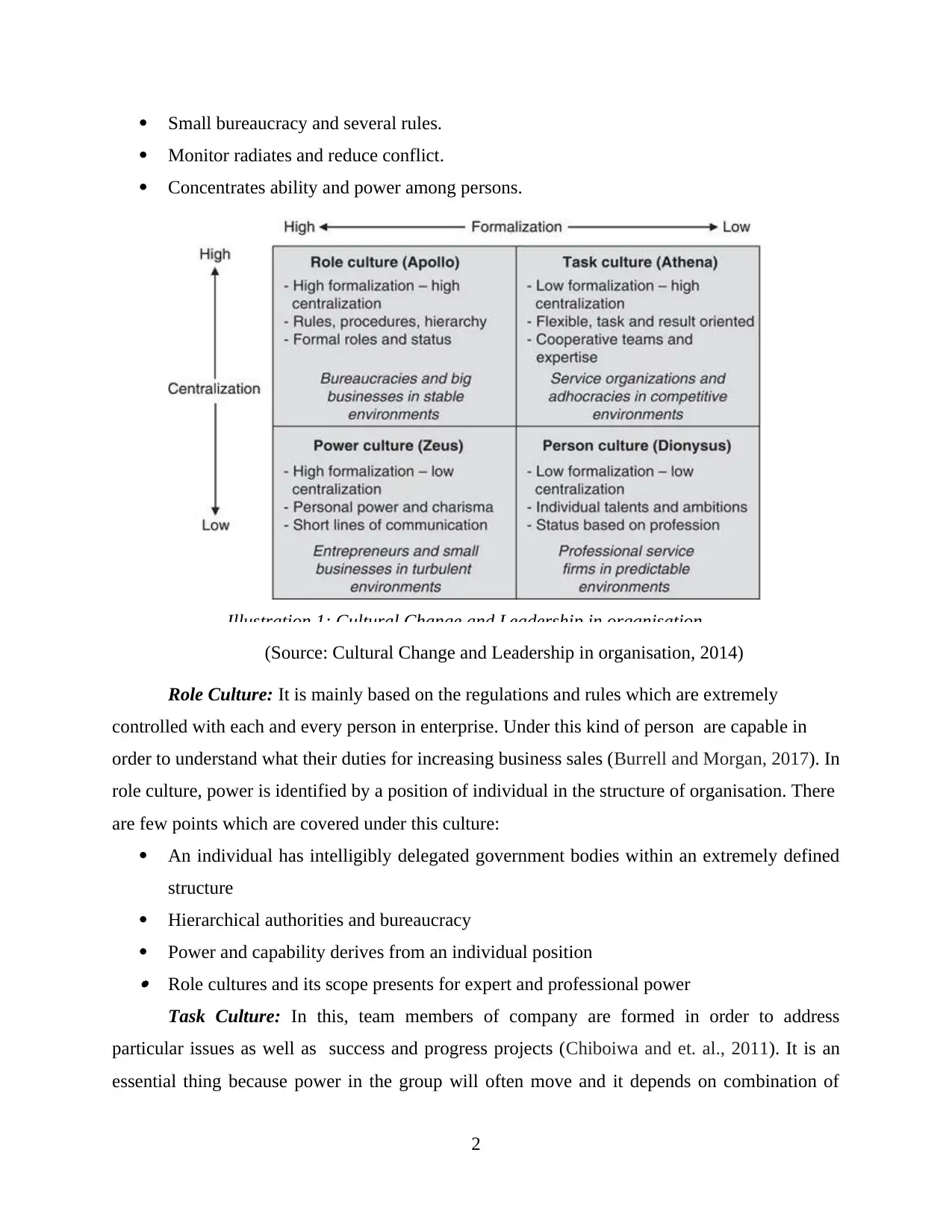
Small bureaucracy and several rules.
Monitor radiates and reduce conflict.
Concentrates ability and power among persons.
Illustration 1: Cultural Change and Leadership in organisation
(Source: Cultural Change and Leadership in organisation, 2014)
Role Culture: It is mainly based on the regulations and rules which are extremely
controlled with each and every person in enterprise. Under this kind of person are capable in
order to understand what their duties for increasing business sales (Burrell and Morgan, 2017). In
role culture, power is identified by a position of individual in the structure of organisation. There
are few points which are covered under this culture:
An individual has intelligibly delegated government bodies within an extremely defined
structure
Hierarchical authorities and bureaucracy
Power and capability derives from an individual position Role cultures and its scope presents for expert and professional power
Task Culture: In this, team members of company are formed in order to address
particular issues as well as success and progress projects (Chiboiwa and et. al., 2011). It is an
essential thing because power in the group will often move and it depends on combination of
2
Monitor radiates and reduce conflict.
Concentrates ability and power among persons.
Illustration 1: Cultural Change and Leadership in organisation
(Source: Cultural Change and Leadership in organisation, 2014)
Role Culture: It is mainly based on the regulations and rules which are extremely
controlled with each and every person in enterprise. Under this kind of person are capable in
order to understand what their duties for increasing business sales (Burrell and Morgan, 2017). In
role culture, power is identified by a position of individual in the structure of organisation. There
are few points which are covered under this culture:
An individual has intelligibly delegated government bodies within an extremely defined
structure
Hierarchical authorities and bureaucracy
Power and capability derives from an individual position Role cultures and its scope presents for expert and professional power
Task Culture: In this, team members of company are formed in order to address
particular issues as well as success and progress projects (Chiboiwa and et. al., 2011). It is an
essential thing because power in the group will often move and it depends on combination of
2
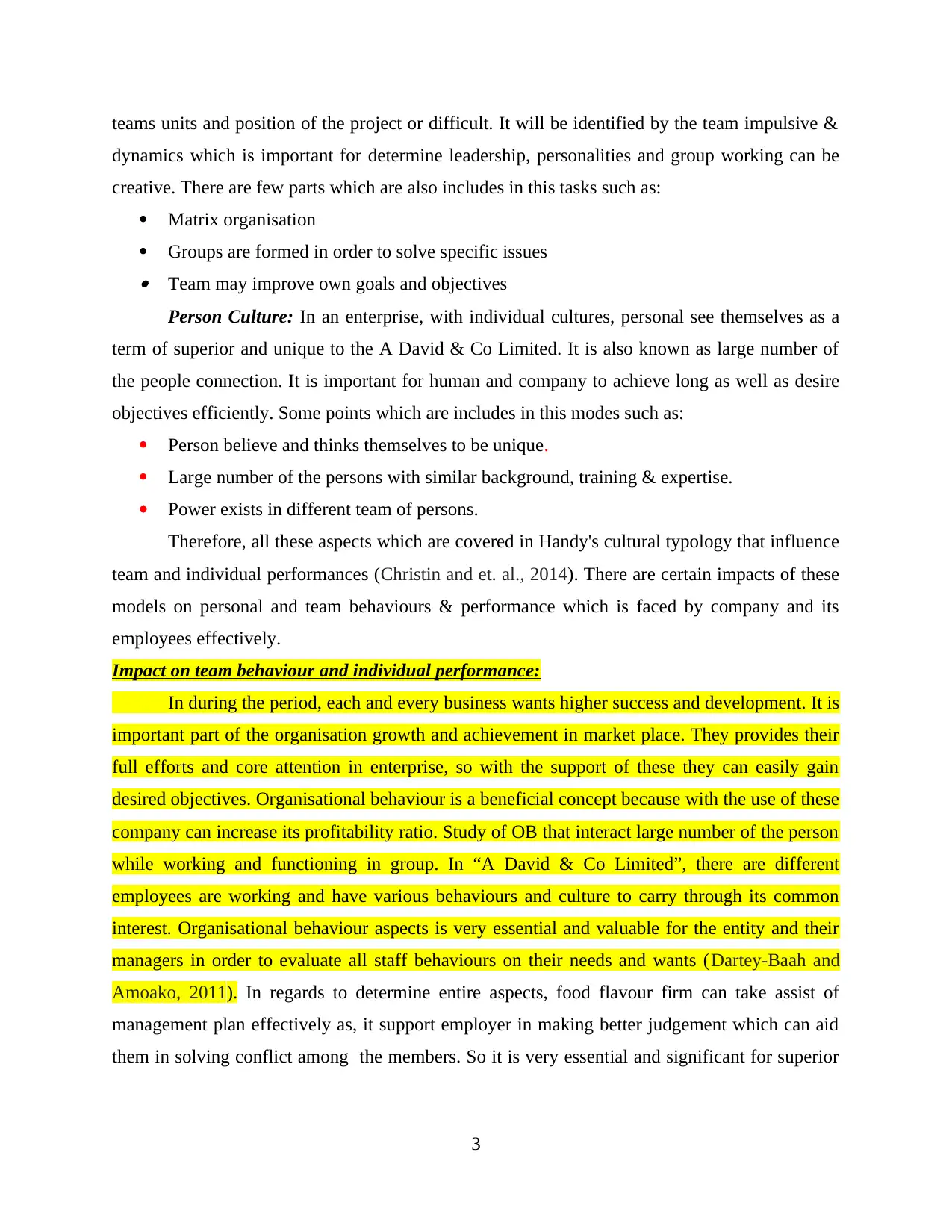
teams units and position of the project or difficult. It will be identified by the team impulsive &
dynamics which is important for determine leadership, personalities and group working can be
creative. There are few parts which are also includes in this tasks such as:
Matrix organisation
Groups are formed in order to solve specific issues Team may improve own goals and objectives
Person Culture: In an enterprise, with individual cultures, personal see themselves as a
term of superior and unique to the A David & Co Limited. It is also known as large number of
the people connection. It is important for human and company to achieve long as well as desire
objectives efficiently. Some points which are includes in this modes such as:
Person believe and thinks themselves to be unique.
Large number of the persons with similar background, training & expertise.
Power exists in different team of persons.
Therefore, all these aspects which are covered in Handy's cultural typology that influence
team and individual performances (Christin and et. al., 2014). There are certain impacts of these
models on personal and team behaviours & performance which is faced by company and its
employees effectively.
Impact on team behaviour and individual performance:
In during the period, each and every business wants higher success and development. It is
important part of the organisation growth and achievement in market place. They provides their
full efforts and core attention in enterprise, so with the support of these they can easily gain
desired objectives. Organisational behaviour is a beneficial concept because with the use of these
company can increase its profitability ratio. Study of OB that interact large number of the person
while working and functioning in group. In “A David & Co Limited”, there are different
employees are working and have various behaviours and culture to carry through its common
interest. Organisational behaviour aspects is very essential and valuable for the entity and their
managers in order to evaluate all staff behaviours on their needs and wants (Dartey-Baah and
Amoako, 2011). In regards to determine entire aspects, food flavour firm can take assist of
management plan effectively as, it support employer in making better judgement which can aid
them in solving conflict among the members. So it is very essential and significant for superior
3
dynamics which is important for determine leadership, personalities and group working can be
creative. There are few parts which are also includes in this tasks such as:
Matrix organisation
Groups are formed in order to solve specific issues Team may improve own goals and objectives
Person Culture: In an enterprise, with individual cultures, personal see themselves as a
term of superior and unique to the A David & Co Limited. It is also known as large number of
the people connection. It is important for human and company to achieve long as well as desire
objectives efficiently. Some points which are includes in this modes such as:
Person believe and thinks themselves to be unique.
Large number of the persons with similar background, training & expertise.
Power exists in different team of persons.
Therefore, all these aspects which are covered in Handy's cultural typology that influence
team and individual performances (Christin and et. al., 2014). There are certain impacts of these
models on personal and team behaviours & performance which is faced by company and its
employees effectively.
Impact on team behaviour and individual performance:
In during the period, each and every business wants higher success and development. It is
important part of the organisation growth and achievement in market place. They provides their
full efforts and core attention in enterprise, so with the support of these they can easily gain
desired objectives. Organisational behaviour is a beneficial concept because with the use of these
company can increase its profitability ratio. Study of OB that interact large number of the person
while working and functioning in group. In “A David & Co Limited”, there are different
employees are working and have various behaviours and culture to carry through its common
interest. Organisational behaviour aspects is very essential and valuable for the entity and their
managers in order to evaluate all staff behaviours on their needs and wants (Dartey-Baah and
Amoako, 2011). In regards to determine entire aspects, food flavour firm can take assist of
management plan effectively as, it support employer in making better judgement which can aid
them in solving conflict among the members. So it is very essential and significant for superior
3
⊘ This is a preview!⊘
Do you want full access?
Subscribe today to unlock all pages.

Trusted by 1+ million students worldwide
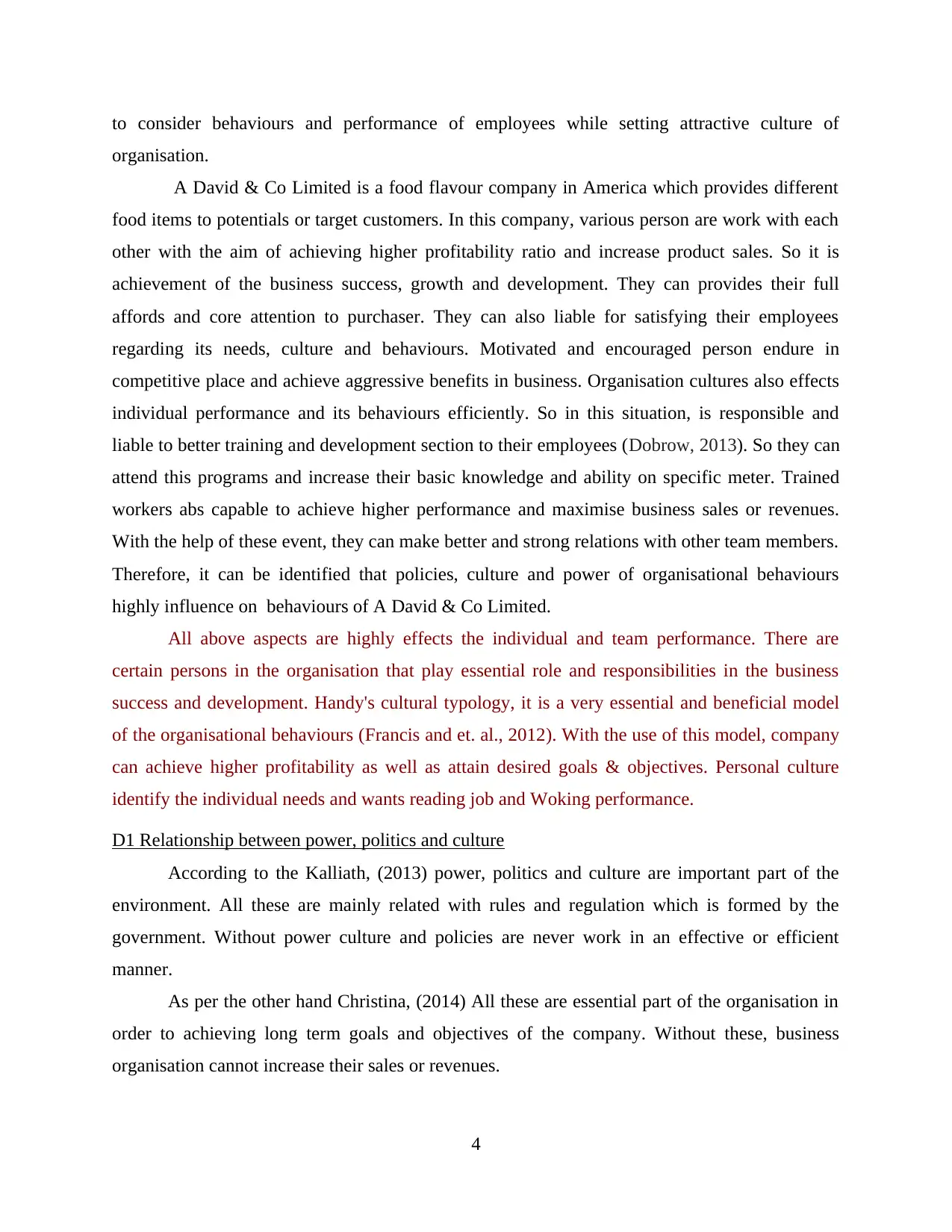
to consider behaviours and performance of employees while setting attractive culture of
organisation.
A David & Co Limited is a food flavour company in America which provides different
food items to potentials or target customers. In this company, various person are work with each
other with the aim of achieving higher profitability ratio and increase product sales. So it is
achievement of the business success, growth and development. They can provides their full
affords and core attention to purchaser. They can also liable for satisfying their employees
regarding its needs, culture and behaviours. Motivated and encouraged person endure in
competitive place and achieve aggressive benefits in business. Organisation cultures also effects
individual performance and its behaviours efficiently. So in this situation, is responsible and
liable to better training and development section to their employees (Dobrow, 2013). So they can
attend this programs and increase their basic knowledge and ability on specific meter. Trained
workers abs capable to achieve higher performance and maximise business sales or revenues.
With the help of these event, they can make better and strong relations with other team members.
Therefore, it can be identified that policies, culture and power of organisational behaviours
highly influence on behaviours of A David & Co Limited.
All above aspects are highly effects the individual and team performance. There are
certain persons in the organisation that play essential role and responsibilities in the business
success and development. Handy's cultural typology, it is a very essential and beneficial model
of the organisational behaviours (Francis and et. al., 2012). With the use of this model, company
can achieve higher profitability as well as attain desired goals & objectives. Personal culture
identify the individual needs and wants reading job and Woking performance.
D1 Relationship between power, politics and culture
According to the Kalliath, (2013) power, politics and culture are important part of the
environment. All these are mainly related with rules and regulation which is formed by the
government. Without power culture and policies are never work in an effective or efficient
manner.
As per the other hand Christina, (2014) All these are essential part of the organisation in
order to achieving long term goals and objectives of the company. Without these, business
organisation cannot increase their sales or revenues.
4
organisation.
A David & Co Limited is a food flavour company in America which provides different
food items to potentials or target customers. In this company, various person are work with each
other with the aim of achieving higher profitability ratio and increase product sales. So it is
achievement of the business success, growth and development. They can provides their full
affords and core attention to purchaser. They can also liable for satisfying their employees
regarding its needs, culture and behaviours. Motivated and encouraged person endure in
competitive place and achieve aggressive benefits in business. Organisation cultures also effects
individual performance and its behaviours efficiently. So in this situation, is responsible and
liable to better training and development section to their employees (Dobrow, 2013). So they can
attend this programs and increase their basic knowledge and ability on specific meter. Trained
workers abs capable to achieve higher performance and maximise business sales or revenues.
With the help of these event, they can make better and strong relations with other team members.
Therefore, it can be identified that policies, culture and power of organisational behaviours
highly influence on behaviours of A David & Co Limited.
All above aspects are highly effects the individual and team performance. There are
certain persons in the organisation that play essential role and responsibilities in the business
success and development. Handy's cultural typology, it is a very essential and beneficial model
of the organisational behaviours (Francis and et. al., 2012). With the use of this model, company
can achieve higher profitability as well as attain desired goals & objectives. Personal culture
identify the individual needs and wants reading job and Woking performance.
D1 Relationship between power, politics and culture
According to the Kalliath, (2013) power, politics and culture are important part of the
environment. All these are mainly related with rules and regulation which is formed by the
government. Without power culture and policies are never work in an effective or efficient
manner.
As per the other hand Christina, (2014) All these are essential part of the organisation in
order to achieving long term goals and objectives of the company. Without these, business
organisation cannot increase their sales or revenues.
4
Paraphrase This Document
Need a fresh take? Get an instant paraphrase of this document with our AI Paraphraser
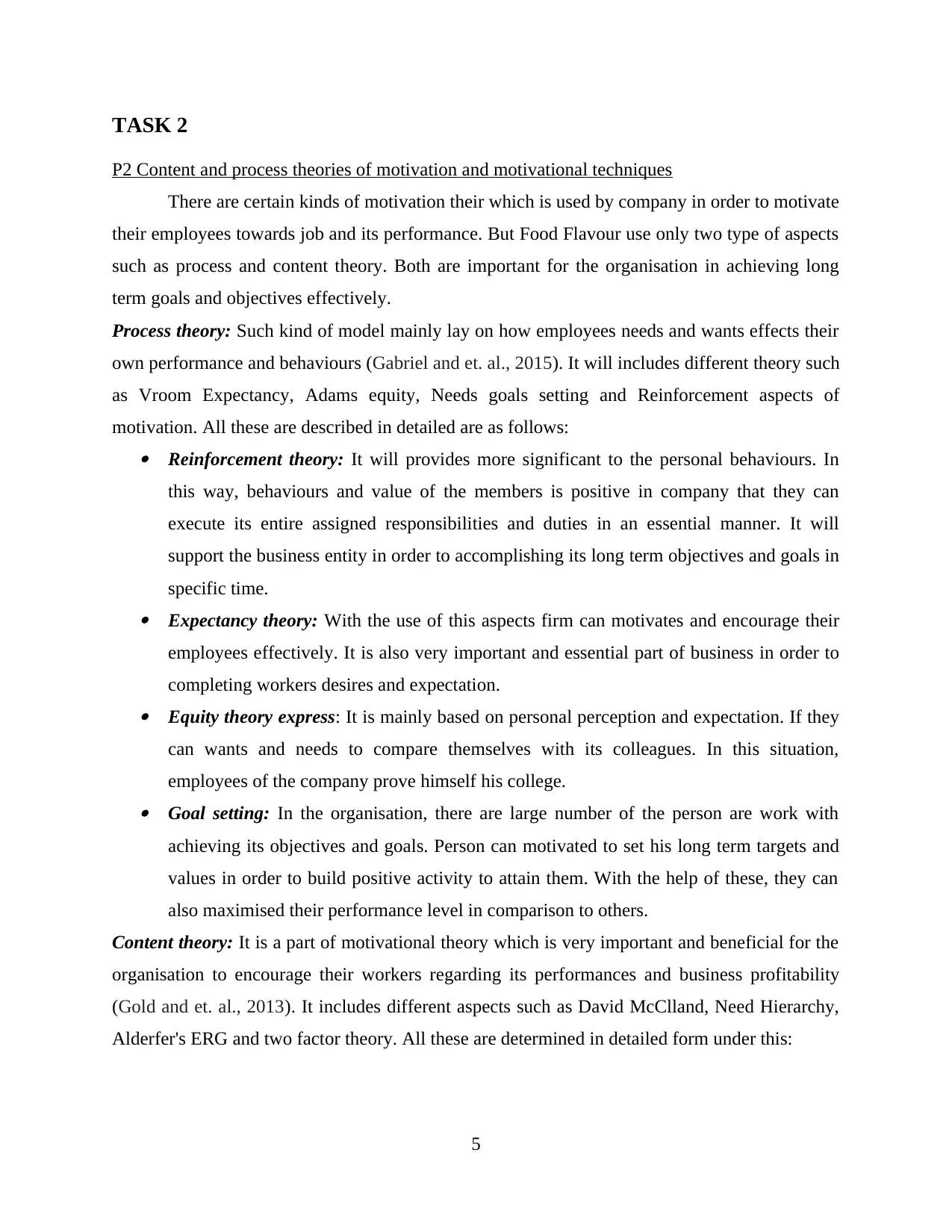
TASK 2
P2 Content and process theories of motivation and motivational techniques
There are certain kinds of motivation their which is used by company in order to motivate
their employees towards job and its performance. But Food Flavour use only two type of aspects
such as process and content theory. Both are important for the organisation in achieving long
term goals and objectives effectively.
Process theory: Such kind of model mainly lay on how employees needs and wants effects their
own performance and behaviours (Gabriel and et. al., 2015). It will includes different theory such
as Vroom Expectancy, Adams equity, Needs goals setting and Reinforcement aspects of
motivation. All these are described in detailed are as follows: Reinforcement theory: It will provides more significant to the personal behaviours. In
this way, behaviours and value of the members is positive in company that they can
execute its entire assigned responsibilities and duties in an essential manner. It will
support the business entity in order to accomplishing its long term objectives and goals in
specific time. Expectancy theory: With the use of this aspects firm can motivates and encourage their
employees effectively. It is also very important and essential part of business in order to
completing workers desires and expectation. Equity theory express: It is mainly based on personal perception and expectation. If they
can wants and needs to compare themselves with its colleagues. In this situation,
employees of the company prove himself his college. Goal setting: In the organisation, there are large number of the person are work with
achieving its objectives and goals. Person can motivated to set his long term targets and
values in order to build positive activity to attain them. With the help of these, they can
also maximised their performance level in comparison to others.
Content theory: It is a part of motivational theory which is very important and beneficial for the
organisation to encourage their workers regarding its performances and business profitability
(Gold and et. al., 2013). It includes different aspects such as David McClland, Need Hierarchy,
Alderfer's ERG and two factor theory. All these are determined in detailed form under this:
5
P2 Content and process theories of motivation and motivational techniques
There are certain kinds of motivation their which is used by company in order to motivate
their employees towards job and its performance. But Food Flavour use only two type of aspects
such as process and content theory. Both are important for the organisation in achieving long
term goals and objectives effectively.
Process theory: Such kind of model mainly lay on how employees needs and wants effects their
own performance and behaviours (Gabriel and et. al., 2015). It will includes different theory such
as Vroom Expectancy, Adams equity, Needs goals setting and Reinforcement aspects of
motivation. All these are described in detailed are as follows: Reinforcement theory: It will provides more significant to the personal behaviours. In
this way, behaviours and value of the members is positive in company that they can
execute its entire assigned responsibilities and duties in an essential manner. It will
support the business entity in order to accomplishing its long term objectives and goals in
specific time. Expectancy theory: With the use of this aspects firm can motivates and encourage their
employees effectively. It is also very important and essential part of business in order to
completing workers desires and expectation. Equity theory express: It is mainly based on personal perception and expectation. If they
can wants and needs to compare themselves with its colleagues. In this situation,
employees of the company prove himself his college. Goal setting: In the organisation, there are large number of the person are work with
achieving its objectives and goals. Person can motivated to set his long term targets and
values in order to build positive activity to attain them. With the help of these, they can
also maximised their performance level in comparison to others.
Content theory: It is a part of motivational theory which is very important and beneficial for the
organisation to encourage their workers regarding its performances and business profitability
(Gold and et. al., 2013). It includes different aspects such as David McClland, Need Hierarchy,
Alderfer's ERG and two factor theory. All these are determined in detailed form under this:
5
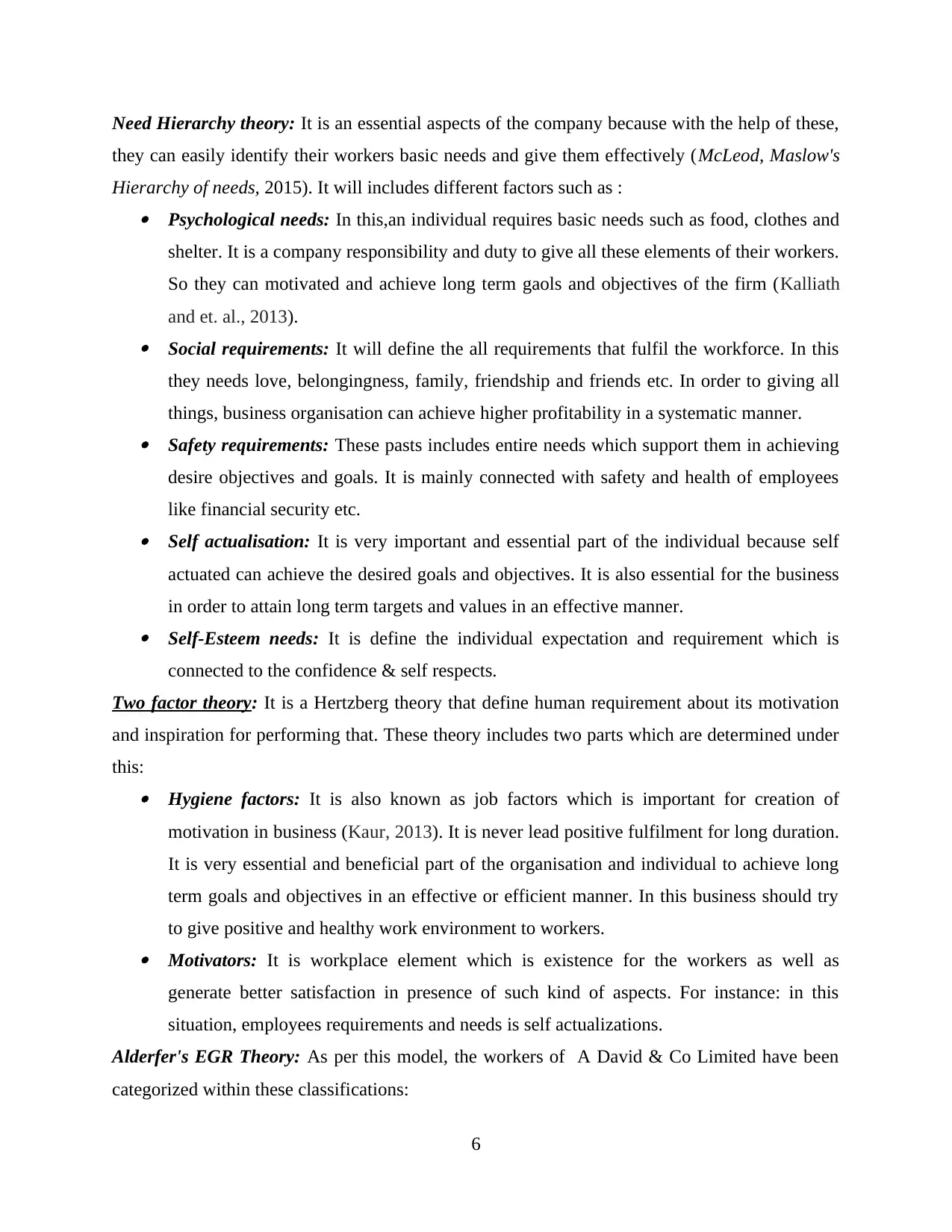
Need Hierarchy theory: It is an essential aspects of the company because with the help of these,
they can easily identify their workers basic needs and give them effectively (McLeod, Maslow's
Hierarchy of needs, 2015). It will includes different factors such as : Psychological needs: In this,an individual requires basic needs such as food, clothes and
shelter. It is a company responsibility and duty to give all these elements of their workers.
So they can motivated and achieve long term gaols and objectives of the firm (Kalliath
and et. al., 2013). Social requirements: It will define the all requirements that fulfil the workforce. In this
they needs love, belongingness, family, friendship and friends etc. In order to giving all
things, business organisation can achieve higher profitability in a systematic manner. Safety requirements: These pasts includes entire needs which support them in achieving
desire objectives and goals. It is mainly connected with safety and health of employees
like financial security etc. Self actualisation: It is very important and essential part of the individual because self
actuated can achieve the desired goals and objectives. It is also essential for the business
in order to attain long term targets and values in an effective manner. Self-Esteem needs: It is define the individual expectation and requirement which is
connected to the confidence & self respects.
Two factor theory: It is a Hertzberg theory that define human requirement about its motivation
and inspiration for performing that. These theory includes two parts which are determined under
this: Hygiene factors: It is also known as job factors which is important for creation of
motivation in business (Kaur, 2013). It is never lead positive fulfilment for long duration.
It is very essential and beneficial part of the organisation and individual to achieve long
term goals and objectives in an effective or efficient manner. In this business should try
to give positive and healthy work environment to workers. Motivators: It is workplace element which is existence for the workers as well as
generate better satisfaction in presence of such kind of aspects. For instance: in this
situation, employees requirements and needs is self actualizations.
Alderfer's EGR Theory: As per this model, the workers of A David & Co Limited have been
categorized within these classifications:
6
they can easily identify their workers basic needs and give them effectively (McLeod, Maslow's
Hierarchy of needs, 2015). It will includes different factors such as : Psychological needs: In this,an individual requires basic needs such as food, clothes and
shelter. It is a company responsibility and duty to give all these elements of their workers.
So they can motivated and achieve long term gaols and objectives of the firm (Kalliath
and et. al., 2013). Social requirements: It will define the all requirements that fulfil the workforce. In this
they needs love, belongingness, family, friendship and friends etc. In order to giving all
things, business organisation can achieve higher profitability in a systematic manner. Safety requirements: These pasts includes entire needs which support them in achieving
desire objectives and goals. It is mainly connected with safety and health of employees
like financial security etc. Self actualisation: It is very important and essential part of the individual because self
actuated can achieve the desired goals and objectives. It is also essential for the business
in order to attain long term targets and values in an effective manner. Self-Esteem needs: It is define the individual expectation and requirement which is
connected to the confidence & self respects.
Two factor theory: It is a Hertzberg theory that define human requirement about its motivation
and inspiration for performing that. These theory includes two parts which are determined under
this: Hygiene factors: It is also known as job factors which is important for creation of
motivation in business (Kaur, 2013). It is never lead positive fulfilment for long duration.
It is very essential and beneficial part of the organisation and individual to achieve long
term goals and objectives in an effective or efficient manner. In this business should try
to give positive and healthy work environment to workers. Motivators: It is workplace element which is existence for the workers as well as
generate better satisfaction in presence of such kind of aspects. For instance: in this
situation, employees requirements and needs is self actualizations.
Alderfer's EGR Theory: As per this model, the workers of A David & Co Limited have been
categorized within these classifications:
6
⊘ This is a preview!⊘
Do you want full access?
Subscribe today to unlock all pages.

Trusted by 1+ million students worldwide
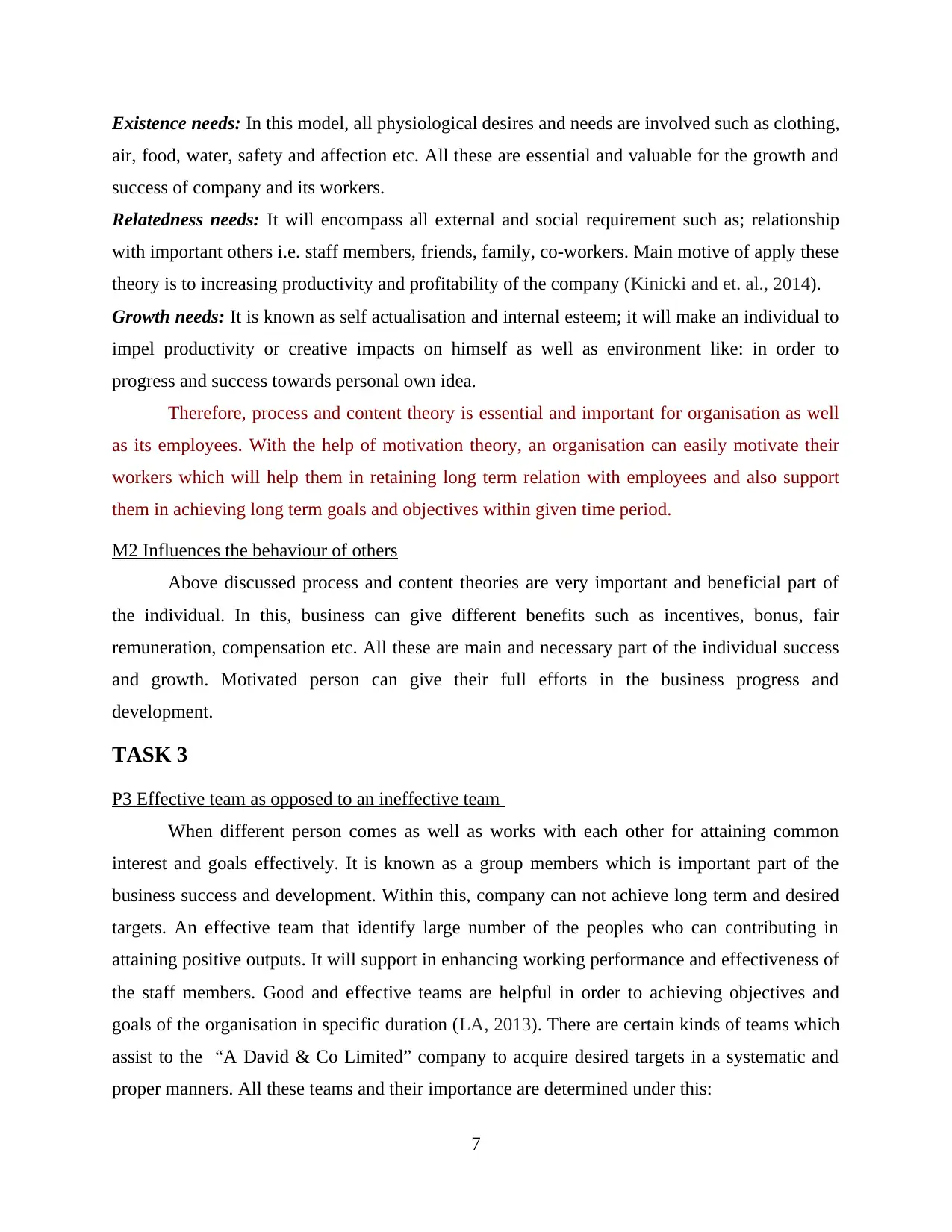
Existence needs: In this model, all physiological desires and needs are involved such as clothing,
air, food, water, safety and affection etc. All these are essential and valuable for the growth and
success of company and its workers.
Relatedness needs: It will encompass all external and social requirement such as; relationship
with important others i.e. staff members, friends, family, co-workers. Main motive of apply these
theory is to increasing productivity and profitability of the company (Kinicki and et. al., 2014).
Growth needs: It is known as self actualisation and internal esteem; it will make an individual to
impel productivity or creative impacts on himself as well as environment like: in order to
progress and success towards personal own idea.
Therefore, process and content theory is essential and important for organisation as well
as its employees. With the help of motivation theory, an organisation can easily motivate their
workers which will help them in retaining long term relation with employees and also support
them in achieving long term goals and objectives within given time period.
M2 Influences the behaviour of others
Above discussed process and content theories are very important and beneficial part of
the individual. In this, business can give different benefits such as incentives, bonus, fair
remuneration, compensation etc. All these are main and necessary part of the individual success
and growth. Motivated person can give their full efforts in the business progress and
development.
TASK 3
P3 Effective team as opposed to an ineffective team
When different person comes as well as works with each other for attaining common
interest and goals effectively. It is known as a group members which is important part of the
business success and development. Within this, company can not achieve long term and desired
targets. An effective team that identify large number of the peoples who can contributing in
attaining positive outputs. It will support in enhancing working performance and effectiveness of
the staff members. Good and effective teams are helpful in order to achieving objectives and
goals of the organisation in specific duration (LA, 2013). There are certain kinds of teams which
assist to the “A David & Co Limited” company to acquire desired targets in a systematic and
proper manners. All these teams and their importance are determined under this:
7
air, food, water, safety and affection etc. All these are essential and valuable for the growth and
success of company and its workers.
Relatedness needs: It will encompass all external and social requirement such as; relationship
with important others i.e. staff members, friends, family, co-workers. Main motive of apply these
theory is to increasing productivity and profitability of the company (Kinicki and et. al., 2014).
Growth needs: It is known as self actualisation and internal esteem; it will make an individual to
impel productivity or creative impacts on himself as well as environment like: in order to
progress and success towards personal own idea.
Therefore, process and content theory is essential and important for organisation as well
as its employees. With the help of motivation theory, an organisation can easily motivate their
workers which will help them in retaining long term relation with employees and also support
them in achieving long term goals and objectives within given time period.
M2 Influences the behaviour of others
Above discussed process and content theories are very important and beneficial part of
the individual. In this, business can give different benefits such as incentives, bonus, fair
remuneration, compensation etc. All these are main and necessary part of the individual success
and growth. Motivated person can give their full efforts in the business progress and
development.
TASK 3
P3 Effective team as opposed to an ineffective team
When different person comes as well as works with each other for attaining common
interest and goals effectively. It is known as a group members which is important part of the
business success and development. Within this, company can not achieve long term and desired
targets. An effective team that identify large number of the peoples who can contributing in
attaining positive outputs. It will support in enhancing working performance and effectiveness of
the staff members. Good and effective teams are helpful in order to achieving objectives and
goals of the organisation in specific duration (LA, 2013). There are certain kinds of teams which
assist to the “A David & Co Limited” company to acquire desired targets in a systematic and
proper manners. All these teams and their importance are determined under this:
7
Paraphrase This Document
Need a fresh take? Get an instant paraphrase of this document with our AI Paraphraser
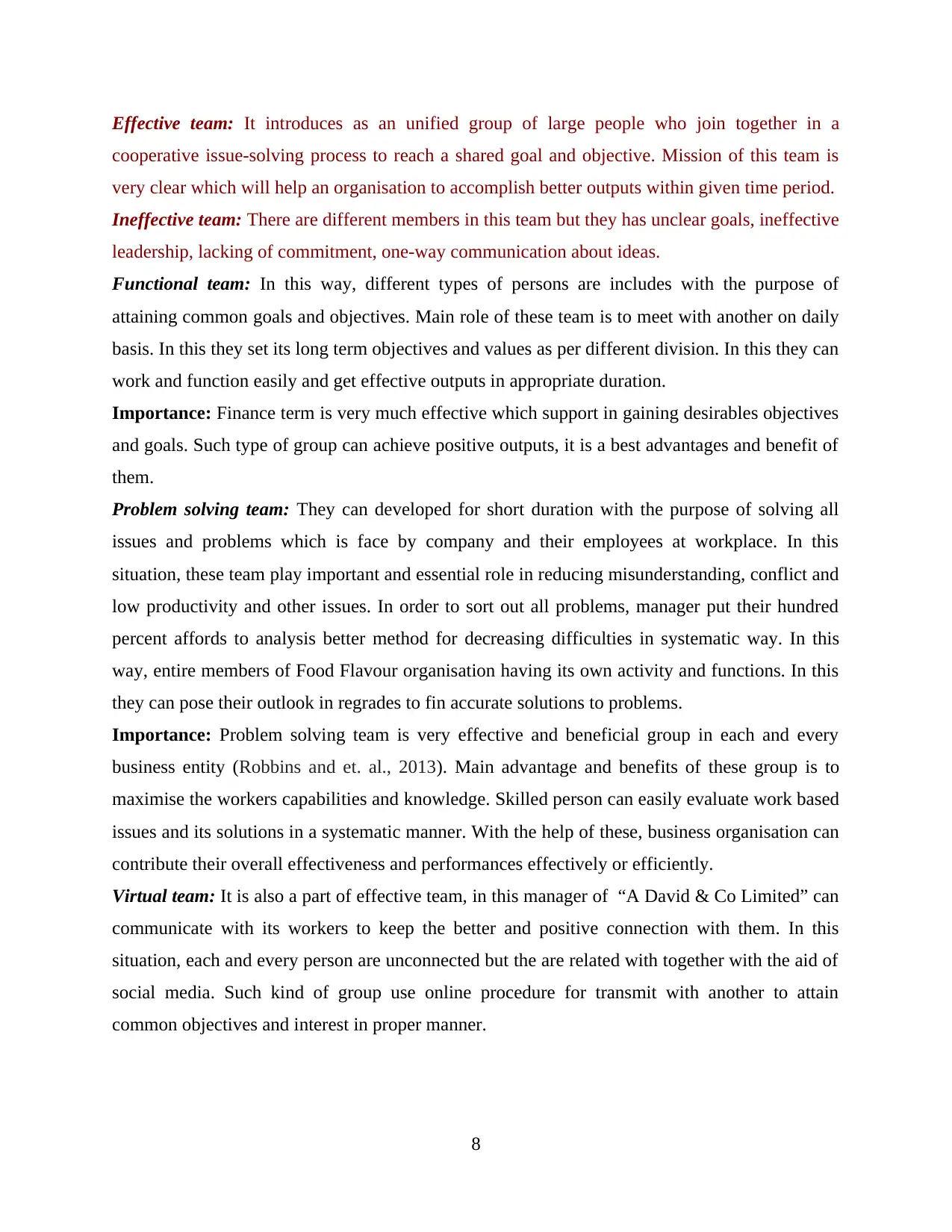
Effective team: It introduces as an unified group of large people who join together in a
cooperative issue-solving process to reach a shared goal and objective. Mission of this team is
very clear which will help an organisation to accomplish better outputs within given time period.
Ineffective team: There are different members in this team but they has unclear goals, ineffective
leadership, lacking of commitment, one-way communication about ideas.
Functional team: In this way, different types of persons are includes with the purpose of
attaining common goals and objectives. Main role of these team is to meet with another on daily
basis. In this they set its long term objectives and values as per different division. In this they can
work and function easily and get effective outputs in appropriate duration.
Importance: Finance term is very much effective which support in gaining desirables objectives
and goals. Such type of group can achieve positive outputs, it is a best advantages and benefit of
them.
Problem solving team: They can developed for short duration with the purpose of solving all
issues and problems which is face by company and their employees at workplace. In this
situation, these team play important and essential role in reducing misunderstanding, conflict and
low productivity and other issues. In order to sort out all problems, manager put their hundred
percent affords to analysis better method for decreasing difficulties in systematic way. In this
way, entire members of Food Flavour organisation having its own activity and functions. In this
they can pose their outlook in regrades to fin accurate solutions to problems.
Importance: Problem solving team is very effective and beneficial group in each and every
business entity (Robbins and et. al., 2013). Main advantage and benefits of these group is to
maximise the workers capabilities and knowledge. Skilled person can easily evaluate work based
issues and its solutions in a systematic manner. With the help of these, business organisation can
contribute their overall effectiveness and performances effectively or efficiently.
Virtual team: It is also a part of effective team, in this manager of “A David & Co Limited” can
communicate with its workers to keep the better and positive connection with them. In this
situation, each and every person are unconnected but the are related with together with the aid of
social media. Such kind of group use online procedure for transmit with another to attain
common objectives and interest in proper manner.
8
cooperative issue-solving process to reach a shared goal and objective. Mission of this team is
very clear which will help an organisation to accomplish better outputs within given time period.
Ineffective team: There are different members in this team but they has unclear goals, ineffective
leadership, lacking of commitment, one-way communication about ideas.
Functional team: In this way, different types of persons are includes with the purpose of
attaining common goals and objectives. Main role of these team is to meet with another on daily
basis. In this they set its long term objectives and values as per different division. In this they can
work and function easily and get effective outputs in appropriate duration.
Importance: Finance term is very much effective which support in gaining desirables objectives
and goals. Such type of group can achieve positive outputs, it is a best advantages and benefit of
them.
Problem solving team: They can developed for short duration with the purpose of solving all
issues and problems which is face by company and their employees at workplace. In this
situation, these team play important and essential role in reducing misunderstanding, conflict and
low productivity and other issues. In order to sort out all problems, manager put their hundred
percent affords to analysis better method for decreasing difficulties in systematic way. In this
way, entire members of Food Flavour organisation having its own activity and functions. In this
they can pose their outlook in regrades to fin accurate solutions to problems.
Importance: Problem solving team is very effective and beneficial group in each and every
business entity (Robbins and et. al., 2013). Main advantage and benefits of these group is to
maximise the workers capabilities and knowledge. Skilled person can easily evaluate work based
issues and its solutions in a systematic manner. With the help of these, business organisation can
contribute their overall effectiveness and performances effectively or efficiently.
Virtual team: It is also a part of effective team, in this manager of “A David & Co Limited” can
communicate with its workers to keep the better and positive connection with them. In this
situation, each and every person are unconnected but the are related with together with the aid of
social media. Such kind of group use online procedure for transmit with another to attain
common objectives and interest in proper manner.
8
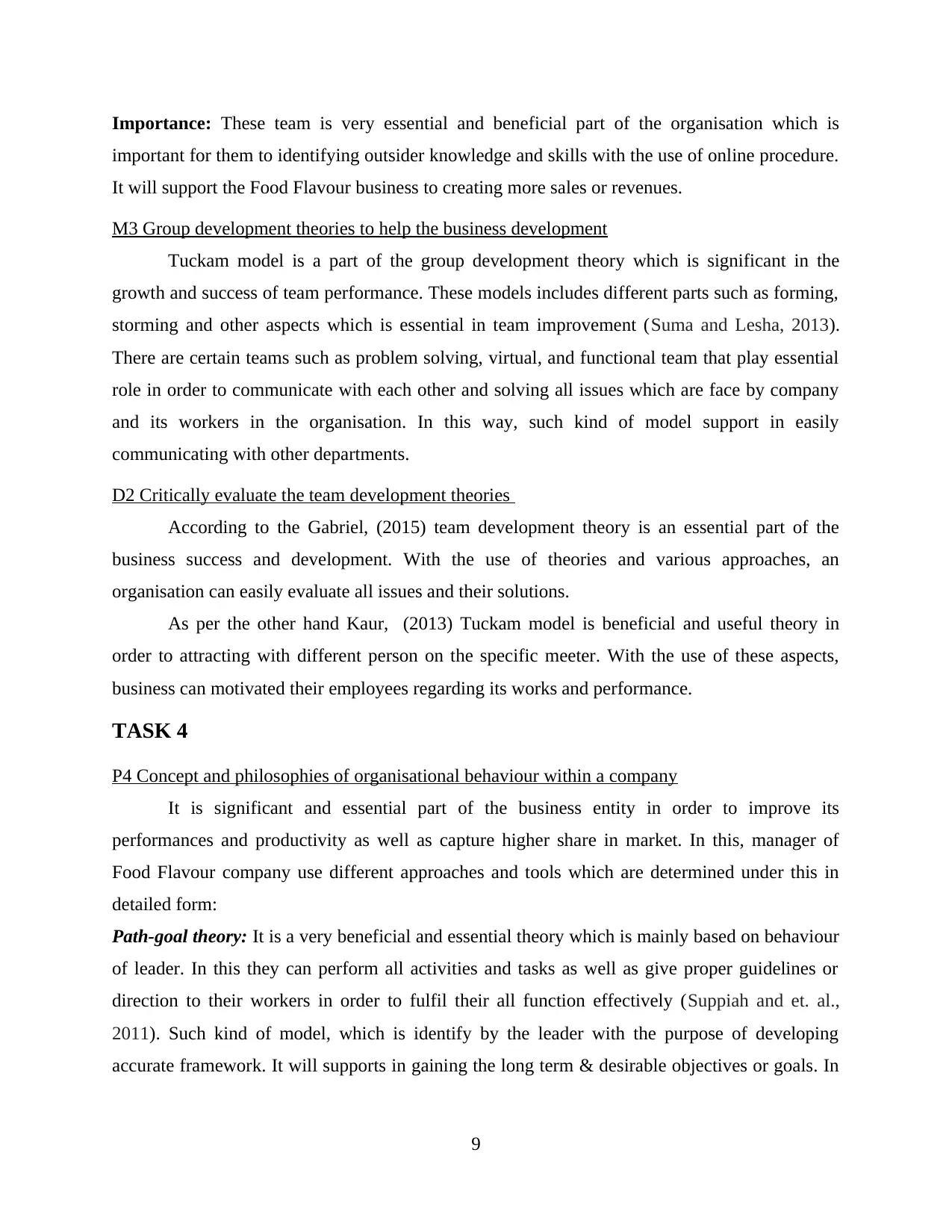
Importance: These team is very essential and beneficial part of the organisation which is
important for them to identifying outsider knowledge and skills with the use of online procedure.
It will support the Food Flavour business to creating more sales or revenues.
M3 Group development theories to help the business development
Tuckam model is a part of the group development theory which is significant in the
growth and success of team performance. These models includes different parts such as forming,
storming and other aspects which is essential in team improvement (Suma and Lesha, 2013).
There are certain teams such as problem solving, virtual, and functional team that play essential
role in order to communicate with each other and solving all issues which are face by company
and its workers in the organisation. In this way, such kind of model support in easily
communicating with other departments.
D2 Critically evaluate the team development theories
According to the Gabriel, (2015) team development theory is an essential part of the
business success and development. With the use of theories and various approaches, an
organisation can easily evaluate all issues and their solutions.
As per the other hand Kaur, (2013) Tuckam model is beneficial and useful theory in
order to attracting with different person on the specific meeter. With the use of these aspects,
business can motivated their employees regarding its works and performance.
TASK 4
P4 Concept and philosophies of organisational behaviour within a company
It is significant and essential part of the business entity in order to improve its
performances and productivity as well as capture higher share in market. In this, manager of
Food Flavour company use different approaches and tools which are determined under this in
detailed form:
Path-goal theory: It is a very beneficial and essential theory which is mainly based on behaviour
of leader. In this they can perform all activities and tasks as well as give proper guidelines or
direction to their workers in order to fulfil their all function effectively (Suppiah and et. al.,
2011). Such kind of model, which is identify by the leader with the purpose of developing
accurate framework. It will supports in gaining the long term & desirable objectives or goals. In
9
important for them to identifying outsider knowledge and skills with the use of online procedure.
It will support the Food Flavour business to creating more sales or revenues.
M3 Group development theories to help the business development
Tuckam model is a part of the group development theory which is significant in the
growth and success of team performance. These models includes different parts such as forming,
storming and other aspects which is essential in team improvement (Suma and Lesha, 2013).
There are certain teams such as problem solving, virtual, and functional team that play essential
role in order to communicate with each other and solving all issues which are face by company
and its workers in the organisation. In this way, such kind of model support in easily
communicating with other departments.
D2 Critically evaluate the team development theories
According to the Gabriel, (2015) team development theory is an essential part of the
business success and development. With the use of theories and various approaches, an
organisation can easily evaluate all issues and their solutions.
As per the other hand Kaur, (2013) Tuckam model is beneficial and useful theory in
order to attracting with different person on the specific meeter. With the use of these aspects,
business can motivated their employees regarding its works and performance.
TASK 4
P4 Concept and philosophies of organisational behaviour within a company
It is significant and essential part of the business entity in order to improve its
performances and productivity as well as capture higher share in market. In this, manager of
Food Flavour company use different approaches and tools which are determined under this in
detailed form:
Path-goal theory: It is a very beneficial and essential theory which is mainly based on behaviour
of leader. In this they can perform all activities and tasks as well as give proper guidelines or
direction to their workers in order to fulfil their all function effectively (Suppiah and et. al.,
2011). Such kind of model, which is identify by the leader with the purpose of developing
accurate framework. It will supports in gaining the long term & desirable objectives or goals. In
9
⊘ This is a preview!⊘
Do you want full access?
Subscribe today to unlock all pages.

Trusted by 1+ million students worldwide
1 out of 16
Related Documents
Your All-in-One AI-Powered Toolkit for Academic Success.
+13062052269
info@desklib.com
Available 24*7 on WhatsApp / Email
![[object Object]](/_next/static/media/star-bottom.7253800d.svg)
Unlock your academic potential
Copyright © 2020–2025 A2Z Services. All Rights Reserved. Developed and managed by ZUCOL.





